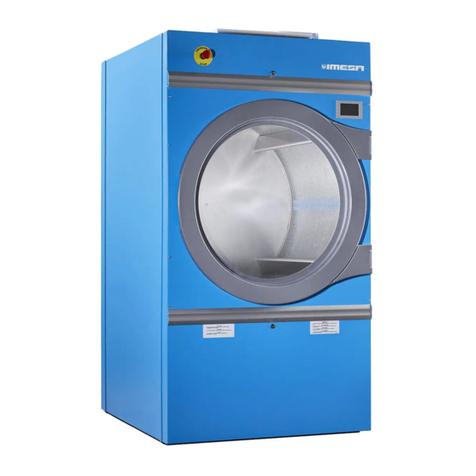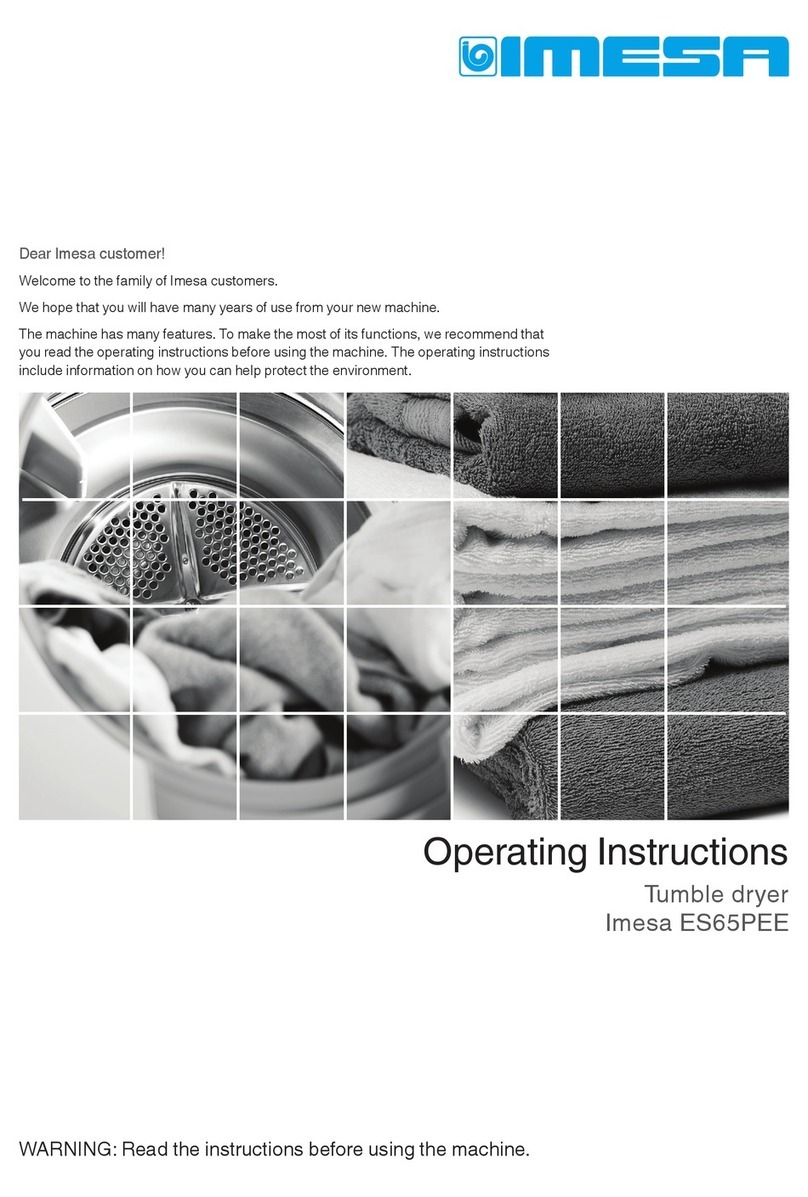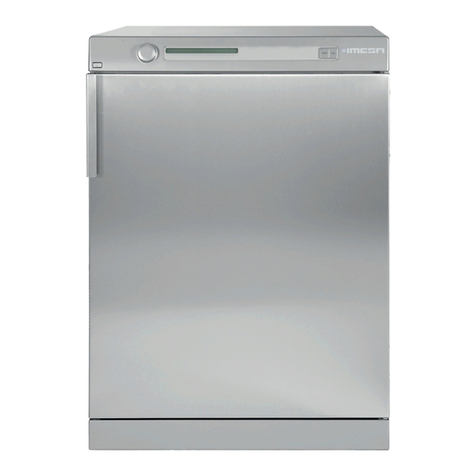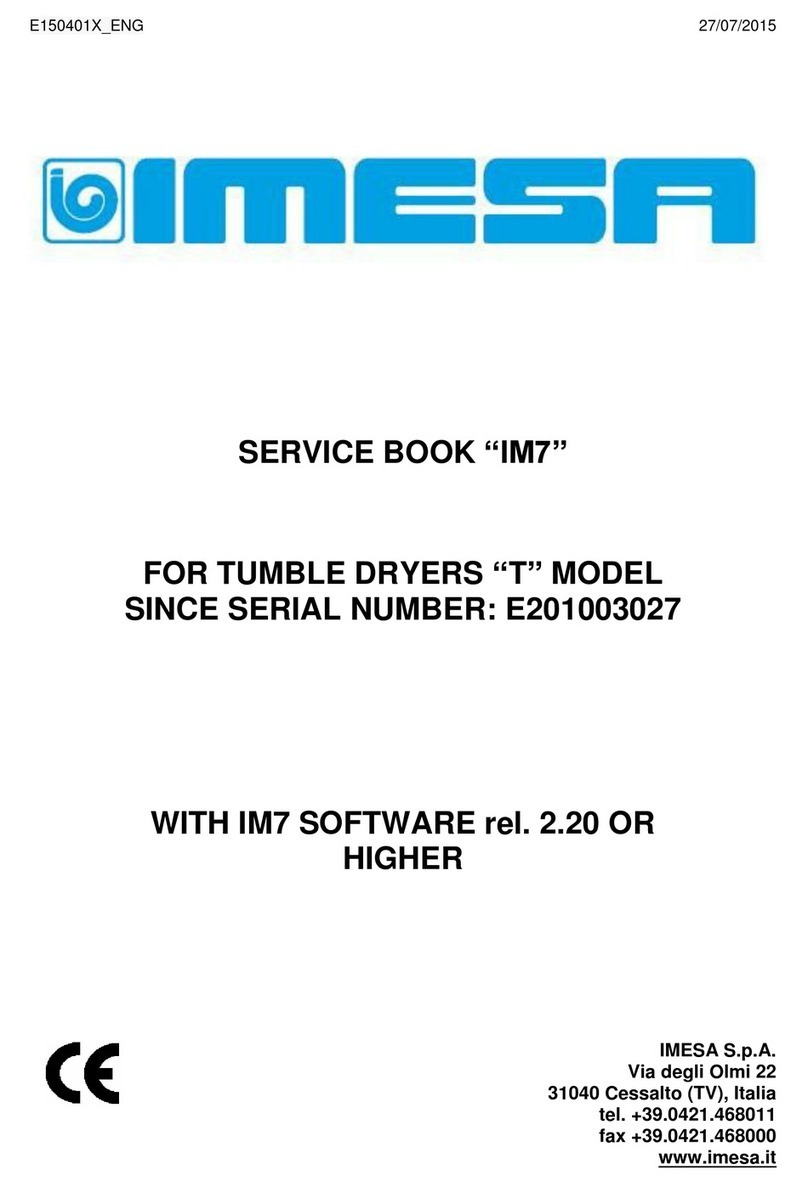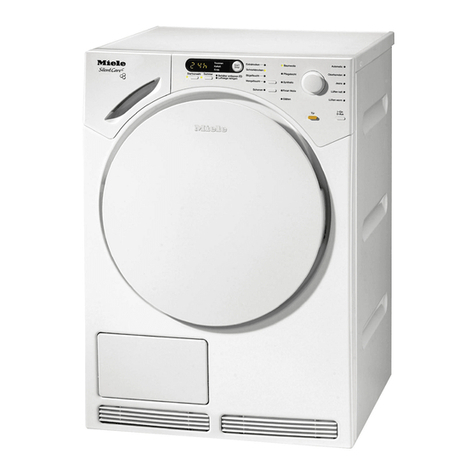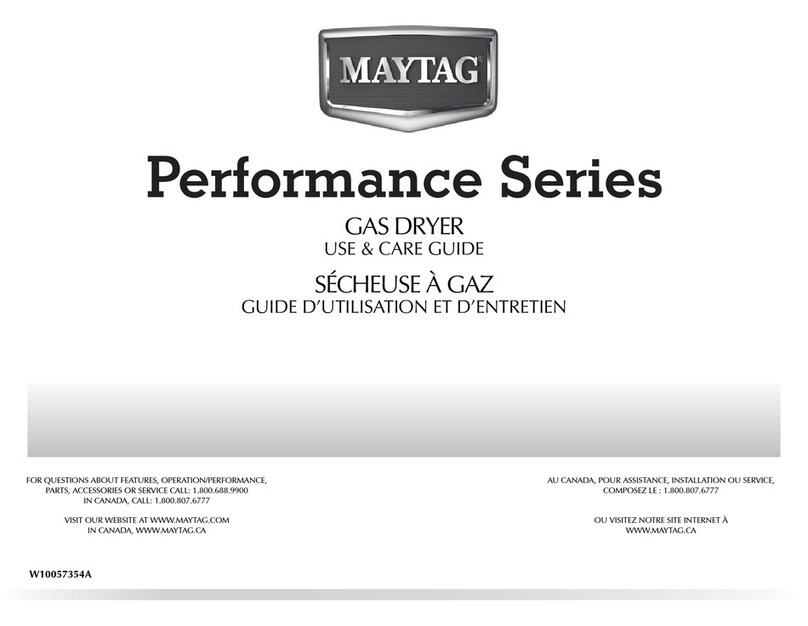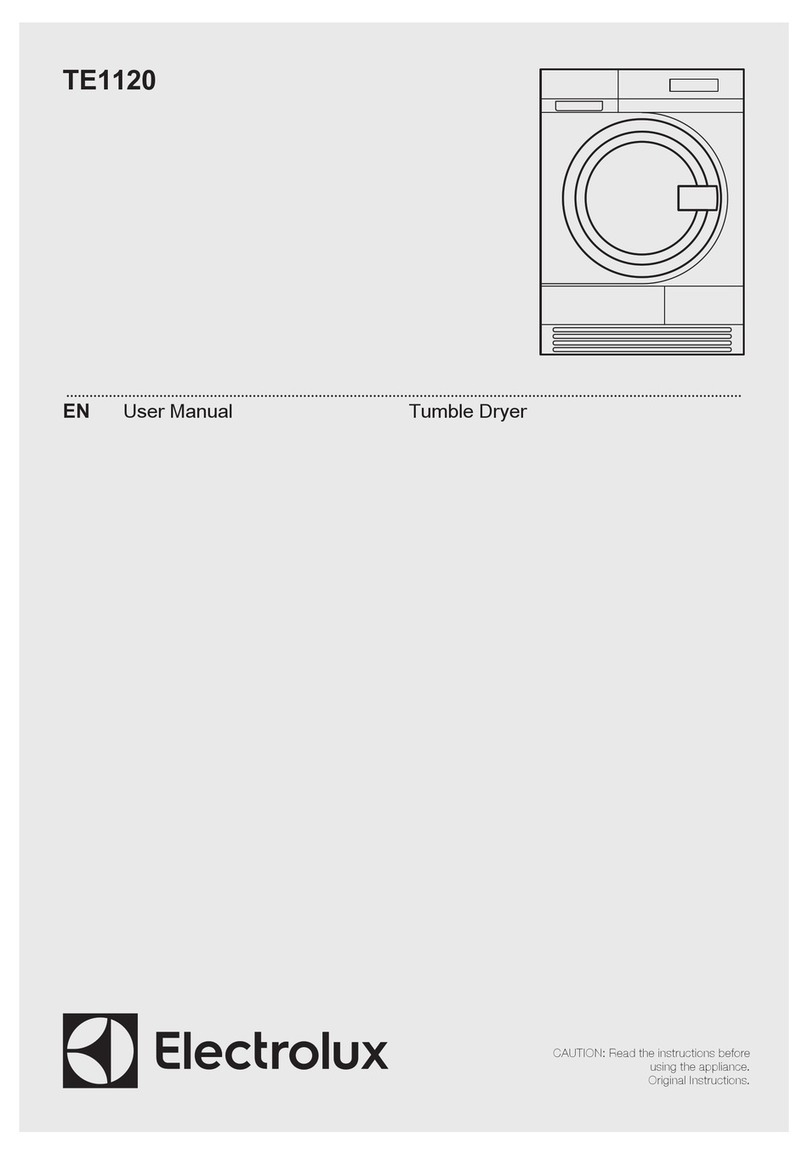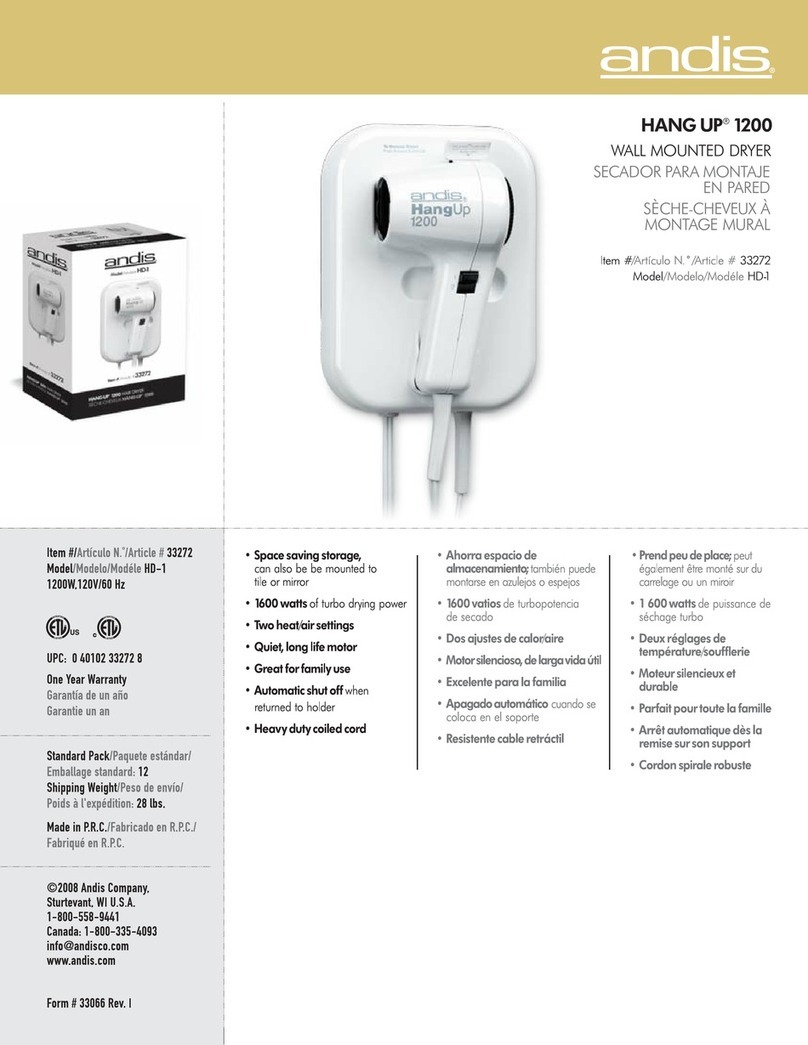Imesa ES7PEE User manual

Operating Instructions
Tumble dryer
IMESA ES7PEE


Dear IMESA customer!
Welcome to the family of IMESA customers.
We hope that you will have many years of use from your new
machine.
The machine has many features. To make the most of its
functions, we recommend that you read the operating
instructions before using the machine. The operating
instructions include information on how you can help protect
the environment.
Operating Instructions
Tumble dryer
IMESA ES7PEE

Before using your machine for the
rst time 5
Language selection 5
Safety instructions 6
Safety 6
Packing material 6
Recycling 6
Child safety 7
General 7
Child-safe start 7
Activating/deactivating Child-safe
start. 7
Description of the tumble dryer 8
Advice and tips before you
tumble-dry 9
Materials that can be tumble-dried 9
Materials that must not be
tumble-dried 9
Static electricity 9
Tumble drying 10
Sort your fabrics 10
Select the programme 11
Press the Start button 13
Drying programme nished 13
Settings 14
You can carry out the following
settings 14
How to choose the settings: 14
Audible Volume 14
Language 14
Child-safe 14
Heater 2 14
Care and cleaning 15
Cleaning the lint lter 15
Cleaning the outside of the machine 15
Troubleshooting 16
The machine will not start 16
The machine loses all power during
a programme 16
Drying takes too long 16
Error messages 16
Technical information 17
Technical data 17
Standard tests 17
Service 18
Before contacting the service division 18
Installation 19
Positioning the tumble dryer 19
Adjusting the feet 20
Air evacuation 20
Electrical installation 22
Door hanging 23
Follow these instructions: 24
Quick guide 26
4
Contents

5
Before using your machine for the rst time
Language selection
You will be prompted to select the display
language when you have connected your
machine and start it for the rst time. Do as
follows:
1. Turn the programme selector to choose from:
US English, English, Svenska, Dansk, Norsk,
Suomi, Français, Deutsch, Italiano, Espanol,
Русский, Nederlands.
2. Press Stop to save the setting.
Laundry labels
Certain materials are not suitable for tumble-
drying. Always check and follow the instructions
on each item’s laundry label. You can nd more
information in the Advice and tips before you
tumble-dry chapter.
NOTE!
When starting the tumble dryer for the rst time
or after a long period without use, you may notice
a slight thumping noise. This noise is completely
normal and will disappear after a few loads.

6
Read the operating instructions
and keep them in a safe place!
• Electrical installation, if required, should be
carried out by a qualied electrician.
• The machine should only be used for tumble-
drying as described in these instructions.
• Repairs and maintenance relating to safety or
performance must be carried out by a qualied
professional.
• Damaged mains cables must only be replaced
by a qualied electrician.
• Sucient ventilation is required to prevent
smoke from open res or fumes from
equipment burning other fuels being sucked
into the room when the tumble dryer is running.
• Do not dry dirty laundry in the tumble dryer.
• Items that are stained with e.g. cooking oil,
acetone, alcohol, petrol, kerosene, stain
remover, turpentine, wax and wax remover
should be washed in hot water with extra
detergent before they go in the tumbler dryer.
• Items such as foam rubber, latex, plastic,
waterproof textiles, rubber-coated items and
clothes and foam-rubber lled cushions must
not be dried in the tumbler dryer.
• Fabric softener or similar products should
be used as per the recommendations of the
detergent manufacturer.
• The machine is not designed to be used by
persons (even children) that are physically
or mentally handicapped or lack experience
and knowledge. Such persons must receive
instruction in how to use the machine from the
person responsible for their safety.
• Children must be watched to ensure they do
not play with the machine.
Safety
• The machine must not be used for drying
items that have been dry-cleaned at home or
fabrics that may contain residues of ammable
liquids.
• Thetumbledryerisprotectedbyanoverheating
cut-out. This shuts o the machine if the
WARNING!O!
When the tumble dryer is operating, the back
of the tumble dryer will get very hot. Leave the
machine to cool completely before touching the
back.
Installation
See the section Installation.
Packing material
Please sort waste materials in accordance with
local guidelines.
Recycling
This machine is manufactured and labelled for
recycling. In order to prevent personal injury,
the machine must be made inoperable after
deciding to take it out of service. Contact your
local authority for information about where and
how your machine should be correctly recycled.
Safety instructions

7
General
WARNING!
Do not allow children to play with
the tumble dryer.
• If the door is opened when a programme is
running the garments may be very hot, with a
risk of burn injuries.
• The tumble dryer does not start automatically
when the door is closed (if a child pulls the
door shut from the inside, for example).
Child-safe start
By activating the child-safe start function you can
prevent children from starting the tumble dryer or
changing the current programme.
Activating/deactivating Child-safe
start.
Do as follows to open the settings menu:
1. Turn o the machine using the main power
switch.
2. Press the Stop button and switch on the
machine with the main power switch. Then
press the Stop button 5 times within 10
seconds.
3. Select the setting you want to change by
turning the programme selector.
4. Press the Stop button once.
5. Change and save the setting as described
below.
6. Press the Start button to return to the
programme menu.
You can activate the Child-safe start option to
prevent children from starting the machine.
1. Turn the programme selector and choose
Child-safe On or Child-safe O.
2. Press the Stop button once to save the setting.
You can temporarily deactivate Child-safe start
by pressing the Start and Stop buttons at the
same time.
Child-safe start will be deactivated for 3 minutes.
Child safety

8
Description of the tumble dryer
1. Main power switch
2. Panel
3. Type plate
4. Lint lter
5. Outer door
1 2 3 4 5

9
Advice and tips before you tumble-dry
Here are some tips that may help you before you
begin tumble-drying.
Have the clothes been spun?
Items to be tumble-dried should be spun at 1000
rpm or faster. Higher spin speeds save energy
and reduce drying time.
Materials that can be tumble-dried
This symbol means that the material is
suitable for tumble-drying. Fabrics best suited
to tumble-drying are cotton fabrics, terry cloth
and synthetic bres. Garments will be softer and
lighter when tumbled than when hung out to dry.
NOTE!
The tumble dryer does not cause any signicant
wear on fabrics. The lint that collects in the lint
lter consists of dust and bre residues formed
when the items are used.
Materials that must not be tumble-
dried
This symbol means that the material is not
suitable for tumble-drying. Certain materials may
melt or become a re hazard if exposed to heat,
and others can lose their shape or shrink.
And do not tumble-dry
• materials labelled "Do not dry near heat".
• garments that have been dry-cleaned at
home.
• plastic foam.
• breglass material.
• wool must not be tumble-dried because of the
risk of felting.
Static electricity
• To reduce the risk of static electricity in the
laundry after tumble drying you can:
• Use fabric softener when washing.
• Wait ve minutes after the drying program
ends before opening the door and removing
the laundry from the dryer.
NOTA!
You can stop the tumble dryer by pressing the
Stop button for three seconds or by opening the
door. In both cases the programme is stopped
and starts from the beginning if restarted.
If you do not want to restart the programme then
immediately remove all laundry and spread it out
to allow the heat to dissipate.

10
Below are step-by-step instructions to help you
achieve the best possible tumble-drying results.
1
Sort your fabrics
You will achieve the most uniform drying
results if the items are made of the same
type of material. Do up zips and buttons, fasten
belts, sort the items and adjust the load and
temperature.
2
Press the main power switch
until the display lights.
NOTE:
Power on
Press the on/o button for min. 1 sec and max.
5 sec.
Power o
Press the on/o button for min. 5 sec.
If the ON/OFF command is not correctly
accepted by the machine, wait min. 8 sec before
any further press.
3
Open the door, load the
items and then close the
door
Tumble drying

11
4
Select the programme
Tumble drying
Guidelines as to what specic
programmes can be used for:
The Auto extra dry, Auto dry and Auto normal
dry programmes have two temperature settings.
Normal temperature but also low temperature for
more delicate items.
Auto extra dry
Temperature normal.This programme is for items
that are particularly dicult to dry, such as jeans
with very thick seams.
Auto dry
Temperature normal. These programmes shut o
the heat once the load is dry but before it is bone
dry. The Auto dry programme shuts o the heat
slightly later than Auto normal dry. Use trial and
error to nd out what works best.
Auto normal dry
Temperature normal. These programmes shut o
the heat once the load is dry but before it is bone
dry. The Auto dry programme shuts o the heat
slightly later than Auto normal dry. Use trial and
error to nd out what works best.
Auto extra dry (low temperature)
Energy Save. This programme is for items that
are particularly dicult to dry, such as jeans with
very thick seams.
Auto dry (low temperature)
Energy Save. These programmes shut o the
heat once the load is dry but before it is bone
dry. The Auto dry programme shuts o the heat
slightly later than Auto normal dry. Use trial and
error to nd out what works best.
Auto normal dry (low temperature)
Energy Save. These programmes shut o the
heat once the load is dry but before it is bone
dry. The Auto dry programme shuts o the heat
slightly later than Auto normal dry. Use trial and
error to nd out what works best.
Auto Iron dry
This programme shuts o the heat once the load
is just damp enough for ironing or pressing.
Select a programme by turning the programme selector.The selected programme is shown in the display
window.
Programme selector StopStart
Programme name

12
Tumble drying
Programme chart
Here we present the energy and time consumption of a few dierent programmes. The table shows the
eect of using dierent spin speeds when washing the load. Consumption can vary depending on room
temperature, humidity, load, variations in the power supply and selected options.
For the consumption values given below, the requirements are as follows:
Temperature of intake air: 23 °C
Moisture content of intake air: 55 %
Drying temperature: Normal
Heater output: 3000W
Program Material Load Spin speed (rpm) Energy consumption,
approx. (kWh)
Programme time,
approx. (min)
Auto extra dry Cotton, linen 1/1 800 rpm 4,0 1:40
1000 rpm 3,8 1:35
1400 rpm 3,3 1:25
1600 rpm 3,1 1:20
Auto dry Cotton, linen 1/1 800 rpm 3,9 1:30
1000 rpm 3,6 1:25
1400 rpm 3,1 1:15
1600 rpm 2,9 1:10
Crease-resistant, polyester/
cotton
1/2 1000 rpm 1,8 0:50
Auto normal dry Cotton, linen 1/1 800 rpm 3,8 1:25
1000 rpm 3,51 1:20
1400 rpm 2,8 1:10
1600 rpm 2,5 1:00
Crease-resistant, polyester/
cotton
1/2 1000 rpm 1,30 0:35
Auto Iron dry Cotton, linen 1/1 800 rpm 3,7 1:35
1000 rpm 3,03 1:25
1400 rpm 2,4 1:05
1600 rpm 2,0 0:50

13
Tumble drying
5
Press the Start button
Remaining drying time
An estimate of the remaining drying time
will be shown on the display a few minutes after
the drying programme starts. For example, 1:35
means that it will take approximately 1 hour and
35 minutes for the load to dry.
The actual remaining time may be longer than
the estimated time shown on the display. The
remaining time is then shown as 0:15 until the
load is suciently dry.
You can stop the tumble dryer by pressing the
Stop button or by opening the door. In both cases
the programme is stopped and starts from the
beginning if restarted.
NOTE!
The programme will not be aected if you change
the programme selector after the programme
has started.
6Drying programme nished
The text Done appears on the display
when the programme is nished.
Backlighting
Two minutes after the drying programme nishes
the backlighting on the display and option buttons
enters energy saving mode.
NOTE!
• Clean the lint lter after each load.
WARNING!
If the lint lter becomes clogged, the machine’s
automatic overheating cut-out may be triggered.
Clean the lter, wait until the machine has cooled
then try starting it. If it still does not start: Call the
service division.
Once drying has nished
Turn o the main power switch. Remove the
clothes and close the door to prevent small
children from climbing into the machine.

14
Settings
You can carry out the following settings
• Language
• Child-safe
• Audible Volume
• Heater 2
How to choose the settings:
Do as follows to open the settings menu:
1. Turn o the machine using the main power switch.
2. Press the Stop button and switch on the machine with the main power switch. Then press the Stop
button 5 times within 10 seconds.
3. Select the setting you want to change by turning the programme selector.
4. Press the Stop button once.
5. Change and save the setting as described below.
6. Press the Start button to return to the programme menu.
Audible Volume
1. Turn the programme selector and choose Buzzer On or Buzzer O to set whether the tumble dryer
should audibly indicate that the programme is nished or that an error has occurred.
2. Press the Stop button once to save the setting.
Language
1. Turn the programme selector to choose from: US English, English, Svenska, Dansk, Norsk, Suomi,
Français, Deutsch, Italiano, Espanol, Русский, Nederlands.
2. Press the Stop button once to save the setting.
Child-safe
You can activate the Child-safe start option to prevent children from starting the machine.
1. Turn the programme selector and choose Child-safe On or Child-safe O.
2. Press the Stop button once to save the setting.
You can temporarily deactivate Child-safe start by pressing the Start and Stop buttons at the same time.
Child-safe start will be deactivated for 3 minutes.
Heater 2
1. Turn the programme selector and choose "Heater 2 On" (3000W/16A) or "Heater 2 O" (1950W/10A)
to increase or decrease the heat output.
2. Press the Stop button once to save the setting.
NOTE!
The switchover must be performed by a qualied electrician.

15
Care and cleaning
Cleaning the lint lter
The lint lter must be cleaned after each load.
1. Grasp the lter holder handle and pull it
towards you to open the lint lter.
2. Open the lint lter. Use your thumb to press on
the edge as illustrated and pull it out.
3. Use your hand or a soft cloth to remove the lint
from all sides of the lter. If necessary, use a
damp sponge and a small amount of washing-
up liquid to remove any deposits. Dry the lter
thoroughly with a towel.
4. Close the lint lter before closing the door.
Cleaning the outside of the
machine
Clean the outside of the machine and the
programme panel with a mild cleaner. Do not use
solvents, as these can damage the machine. Do
not hose down or spray the machine with water.
NOTE!
Do not allow dust to accumulate around the
machine. Keep the area around the tumble dryer
clean and cool; dust, heat and moisture prolong
drying times.

16
Troubleshooting
The machine will not start
Check
• that the door is properly closed.
• that the main power switch is on.
• that the plug is connected.
• that the main fuses have not blown.
• that the overheating cut-out has not been
triggered.
The machine loses all power
during a programme
The overheating cut-out shuts o the tumble
dryer if the temperature is too high, e.g. because
dust is clogging the lint lter.
• Clean the lint lter.
• Wait until the machine has cooled then try
starting it. If it still does not start: Call the
service division.
Drying takes too long
• Check that the lint lter is not blocked. See the
Care and cleaning chapter.
Error messages
• Read Drying takes too long in this chapter if
Max program time appears on the display.
• If Clean Lint Filter appears on the display,
clean the lint lter.
• Call the service division if Thermistor fault
appears on the display.
• Press the Stop button to close any error
messages.

17
Technical data
Height: 850 mm
Width: 595 mm
Depth: 585 mm
Weight (net): 40 kg
Cylinder volume: 112 l
Max. drying capacity: 7 kg
Speed: 50-55 rpm
Rated power: See type plate.
Drum material: Stainless steel
Outer casing material: Powder-coated and hot-galvanized sheet steel or stainless
steel.
Setup Stacking or freestanding
Standard tests
Europe:
Drying performance: EN 611 21 (95/13/EEC).
Auto normal dry, 7 kg cotton
Energy declaration: EN 611 21 (95/13/EEC).
Auto normal dry, 7 kg cotton
Test method for noise
measurement:
IEC 60 704-2-6.
Technical information

18
Service
Before contacting the service
division
See the Troubleshooting and Care and cleaning
chapters to see whether you can rectify the
problem.
If you need to contact the service division, make
sure that you know the model designation, type
designation and serial number.
The model designation (1) can be found on the
rst page of the operating instructions and on
the machine panel. The type designation (2) and
serial number (3) can be found on the type plate,
which is found on the front of the tumble dryer
inside the outer door.
1
3
TYPE
2

19
Installation
Positioning the tumble dryer
The tumble dryer can be free-standing or in a
stack. Remember that the tumble dryer produces
heat and should therefore not be located in a
room that is too small. If the room is very small,
drying will take longer due to the limited quantity
of air.
WARNING!
• Any electrical installation must be carried out
by qualied professionals.
• The machine must not be installed behind a
lockable door, a sliding door or a door with
hinges on the opposite side to those of the
tumble dryer.
• The tumble dryer's plinth ventilation must not
be blocked by a rug or the like.
NOTE!
To improve ventilation, leave the door to the room
where the tumble dryer is located open.
Freestanding
The tumble dryer can be positioned beside the
washing machine. An air gap of at least 5 mm
must be left between the washing machine and
the tumble dryer.
Stacking
The tumble dryer can be placed on top of a IMESA
washing machine. Use the two foot cups found
in the document bag included with the machine
and the two tip guards attached to the bottom left
corner of the back of the machine.
How to assemble the stack:
1. Remove the two tip guards from the back of
the tumble dryer. Replace the screws that held
the tip guards in place.
2. Undo the two screws indicated on the back of
the washing machine.
3. Secure the anti-tilt device using the screws as
shown in the picture.
4. Attach the plastic cups for xing the tumble
dryer’s front feet to the washing machine’s
top cover. This is essential, as only when the
tumble dryer’s feet are resting in the plastic
cups can you be sure that the tumble dryer is
correctly positioned on the washing machine.
Break o tag A on the cup tted on the right-
hand side and tag B on the cup tted on the
left-hand side. Then remove the paper from
the self-adhesive surface under the plastic
cups.
A
B

20
Installation
5. Fit the plastic cups so that the “tags” marked
with arrows are against the front edge or side
edge of the cover and press them rmly onto
the cover. Then break o the remaining tags.
6. Push out the knock-out hole on the back of
the tumble dryer (you must not remove it, just
open it) using a hammer and screwdriver.
7. Push the tumble dryer in under the metal
brackets. At the same time keep the front edge
raised by 10 mm to 20 mm.
8. Lower the tumble dryer’s front feet into the
plastic cups and adjust the tumble dryer to
ensure it is level.
Adjusting the feet
Screw the feet in or out so that the tumble dryer is
both stable and level.
Air evacuation
The air vented from the tumble dryer must be
channelled to an exhaust air duct or an exhaust
outlet in the wall using the supplied vent hose.
Connection to the tumble dryer
The tumble dryer has three options for venting
air: at the back, on the right side and on the left
side. One hole is open when the tumble dryer is
supplied. The other two have covers. The tumble
dryer comes with a connector (1), a plastic band
(2) and a vent hose (3).
1
2
3
Fit the air evacuation system as follows:
1. Slip the vent hose onto the connector and
secure it using the plastic band.
2. Remove the plastic cover if you want to t the
vent hose to one of the holes other than the
one already open.
3. Insert the connector with the vent hose into the
opening.
4. Place the cover over the open hole.
Table of contents
Other Imesa Dryer manuals
Popular Dryer manuals by other brands
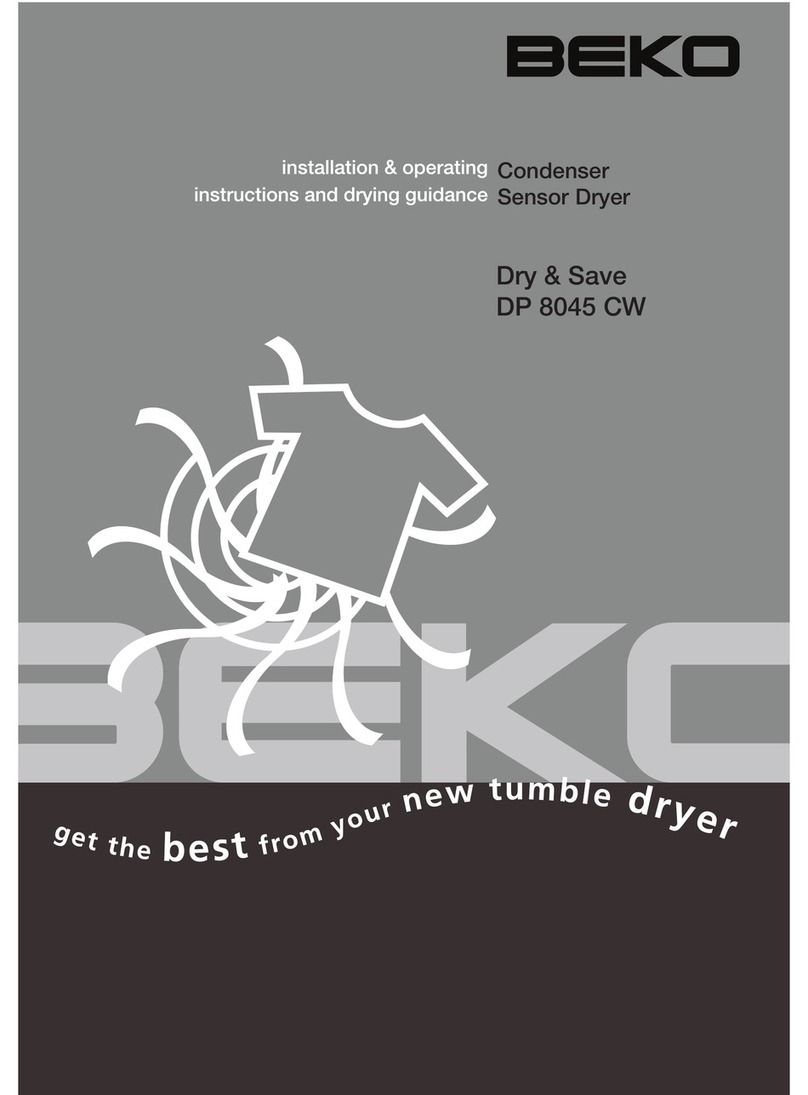
Beko
Beko DP 8045 CW Installation & operating manual

Maytag
Maytag NEPTUNE MD68 Use & care guide
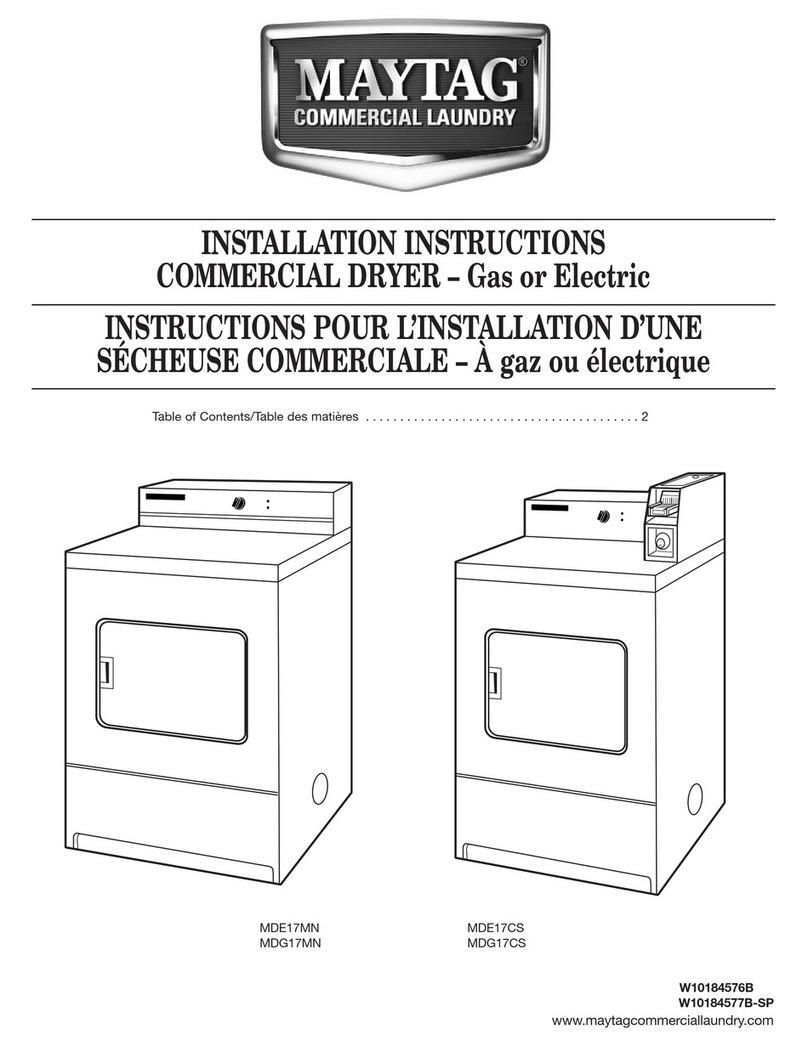
Maytag
Maytag MDE17MN installation instructions
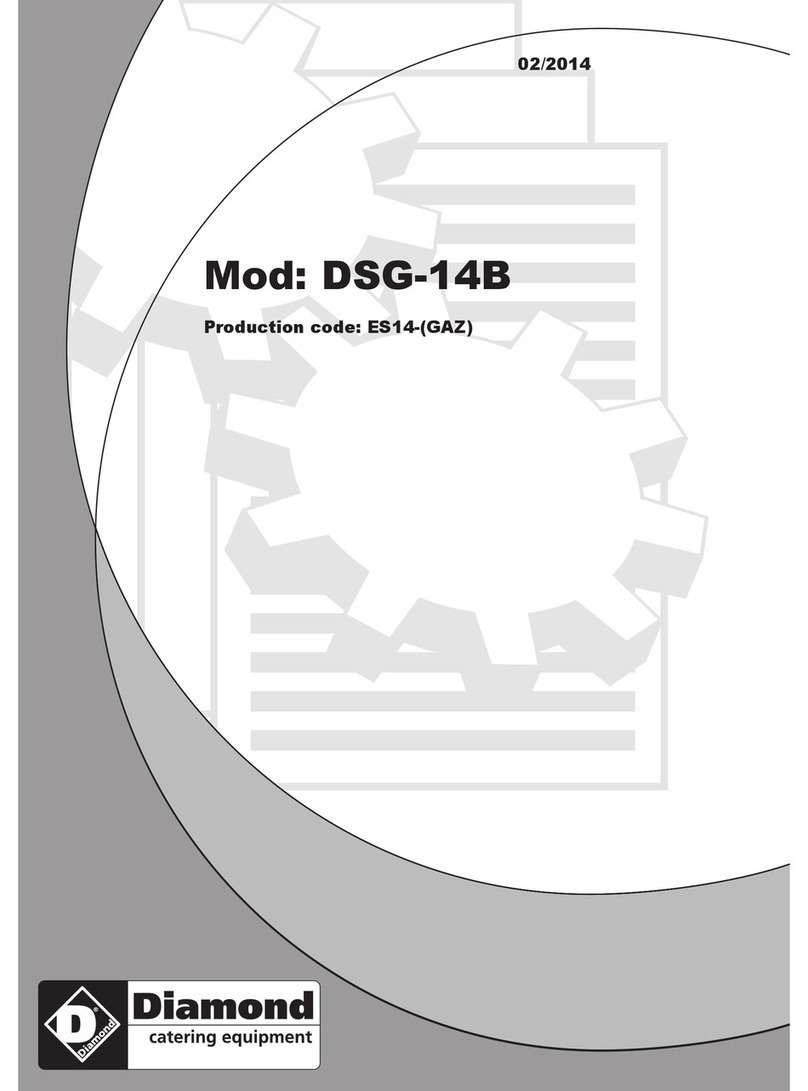
Diamond
Diamond DSG-14B Installation, use and maintenance instructions
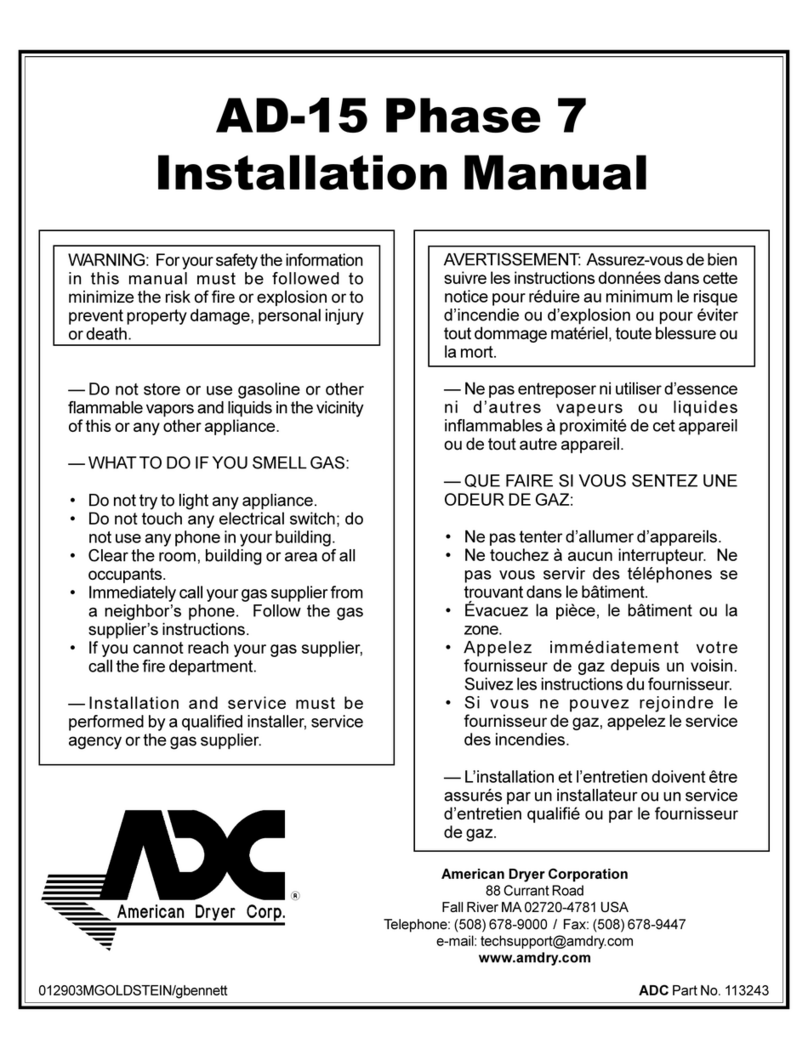
American Dryer Corp.
American Dryer Corp. AD-15 Phase 7 installation manual
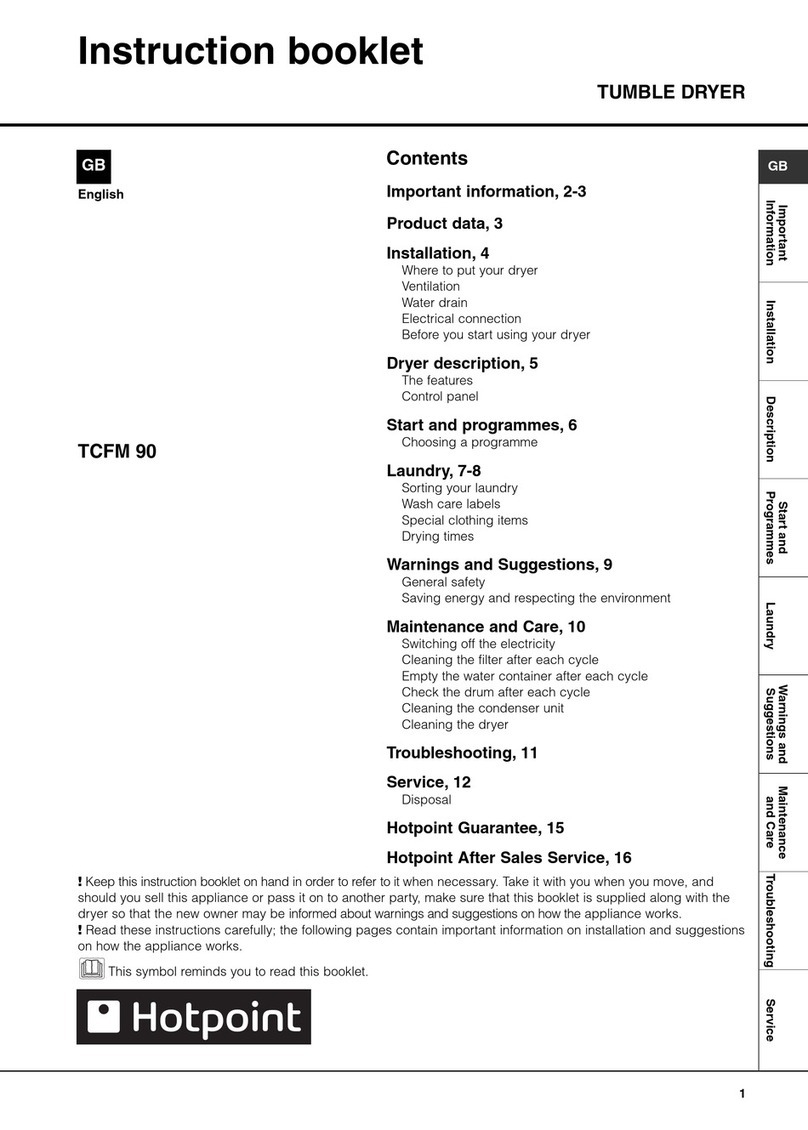
Indesit
Indesit TCFM 90 Instruction booklet

